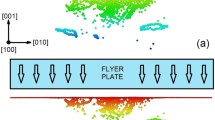Abstract
We will begin our discussion with a reminder of the basic properties of single dislocations and conclude by considering combinations of dislocations, which will lead nicely into the next three chapters, which consider different types of interfaces.
Most students understand dislocations best by thinking about schematic diagrams and high-resolution transmission electron microscopy (TEM) images. Dislocations are line defects, but like all crystal defects, they are actually volume defects; i.e., we should think of them as tubes, or pipes, whose properties change across the tube radius and that generally do not have cylindrical symmetry.
We are not trying to cover everything about dislocations here; rather we will review the basic features of dislocations and then introduce the complexities of ceramics. Remember the important experimental observation that led to the “invention” of dislocations: the stress required to deform a metal single crystal is at least 103 times smaller than the theoretical value.
Two vectors define the fundamental properties of any dislocation:
-
The line direction
-
The Burgers vector
The glide plane of the dislocation is the plane that contains both vectors. To summarize: Geometry Burgers vector and line direction define the glide plane. Displacement When a dislocation is present, atoms are displaced from their positions in the perfect crystal; the material is strained so there must be a stress. Movement Dislocations move and interact (they even intersect). Reacting We generate dislocations, they multiply and combine (by intersecting).
Why consider dislocations in ceramics? Conventional wisdom says that dislocations are not nearly as important in the mechanical deformation of ceramics as they are for metals. The reason is that dislocations in ceramics do not move as easily as those in metals and they are usually not as numerous. So we should be asking why the last sentence is true. Dislocations in ceramics are extremely important because of what they do not do: they do not glide easily. Si devices would not work for long and ceramics, in general, would not be brittle if dislocations could glide easily. Understanding dislocations also helps us understand other more complex defects, how they interact with point defects, and how they can cause planar defects. Dislocations become very important when we use thin crystalline ceramic films, particularly when grown on crystalline substrates.
What is special about dislocations in ceramics?
-
Complex and large unit cells are the norm rather than the exception.
-
Charge—if you insert an extra half plane to make an edge dislocation, you must consider the charge.
-
Directional bonds—if you break a bond, does it reform?
For the student, dislocations are a great test of whether the structure of a crystal is understood. They give a fine probe of what is happening in the material. Be aware though that much of our understanding of dislocations comes from metallurgy, particularly from studies on Cu alloys. We often compare our dislocations to these, since those in metals are quite well understood, but ceramics do introduce new complications. A detailed understanding of dislocations and planar defects in ceramics is not as advanced as that of point defects.
Access this chapter
Tax calculation will be finalised at checkout
Purchases are for personal use only
Preview
Unable to display preview. Download preview PDF.
Similar content being viewed by others
General References
Amelinckx, S. (1964) “The direct observation of dislocations,” Solid State Phys. Suppl. 6. One of the best “papers” ever written on the subject.
Hirth, J.P. and Lothe, J. (1982) Theory of Dislocations, 2nd edition, Wiley, New York. One of the two standard works on the subject. Inspirational. Professor Hirth retired from Washington State University in 2003.
Hull, D. and Bacon, D.J. (1984) Introduction to Dislocations, 3rd edition, Pergamon Press, Oxford. Bedtime reading for the materials scientist.
Nabarro, F.R.N. (1987) Theory of Crystal Dislocations, Dover Publications, New York. This was first published by the Clarendon Press (Oxford University Press) in 1967. The other standard work by one of the founders of dislocation theory. Professor Nabarro also edited the series Dislocations.
Weertman, J. and Weertman, J.R. (1992) Elementary Dislocation Theory, Oxford University Press, New York. Similar to H&B but with more equations and no micrographs.
Specific References
Amelinckx, S., Bontinck, W., and Dekeyser, W. (1957) “Helical dislocations and spiral etch-pits,” Philos. Mag. 2, 1264.
Carter, C.B. and Kohlstedt, D.L. (1981) “Electron irradiation damage in natural quartz grains,” Phys. Chem. Minerals 7, 110.
Hornstra, J. (1960) “Dislocations, stacking faults and twins in the spinel structure,” J. Phys. Chem. Sol. 15, 311.
Kodambaka, S., Khare, S.V., Swiech, W., Ohmori, K., Petrov. I., and Greene, J.E. (2004) “Dislocation-driven surface dynamics on solids,” Nature 429, 49.
Kronberg M.L. (1957) “Plastic deformation of single crystals of sapphire—basal slip and twinning,” Acta Metal. 5, 507.
Lee, W.E. and Lagerlof, K.P.D. (1985) “Structural and electron-diffraction data for sapphire (alpha-Al2O3),” J. Electron. Microsc. Techn. 2, 247.
Narayan, J. (1972) “Self-climb of dislocation loops in magnesium-oxide,” Philos. Mag. 26, 1179.
Rabier, J. and Puls, M.P. (1989) “On the core structures of edge dislocations in NaCl and MgO. Consequences for the core configurations of dislocation dipoles,” Philos. Mag. A 59(4), 821.
Ray, I.L.F. and Cockayne, D.J.H. (1971) “The dissociation of dislocations in silicon,” Proc. R. Soc. Lond. A 325, 543.
Washburn, J., Kelly, A., and Williamson, G.K. (1960) “Direct observations of dislocations in magnesium oxide,” Philos. Mag. 5, 192.
Weertman, J. (1957) “Helical dislocations,” Phys. Rev. 107(5), 1259.
Rights and permissions
Copyright information
© 2007 Springer Science+Business Media, LLC
About this chapter
Cite this chapter
(2007). Are Dislocations Unimportant?. In: Ceramic Materials. Springer, New York, NY. https://doi.org/10.1007/978-0-387-46271-4_12
Download citation
DOI: https://doi.org/10.1007/978-0-387-46271-4_12
Publisher Name: Springer, New York, NY
Print ISBN: 978-0-387-46270-7
Online ISBN: 978-0-387-46271-4
eBook Packages: Chemistry and Materials ScienceChemistry and Material Science (R0)




